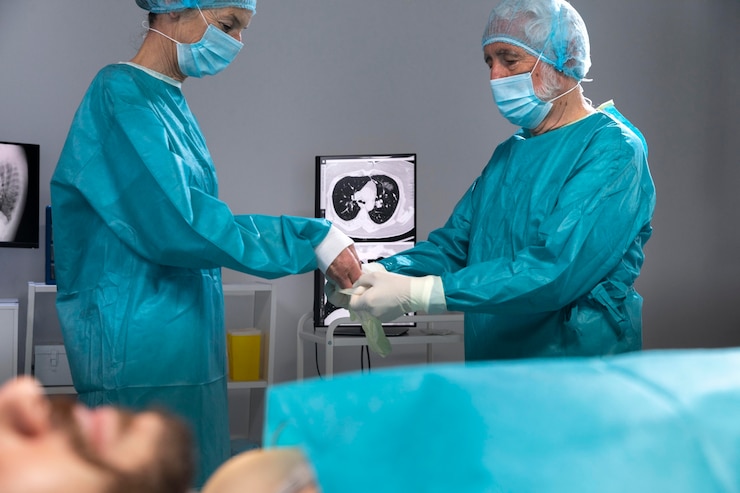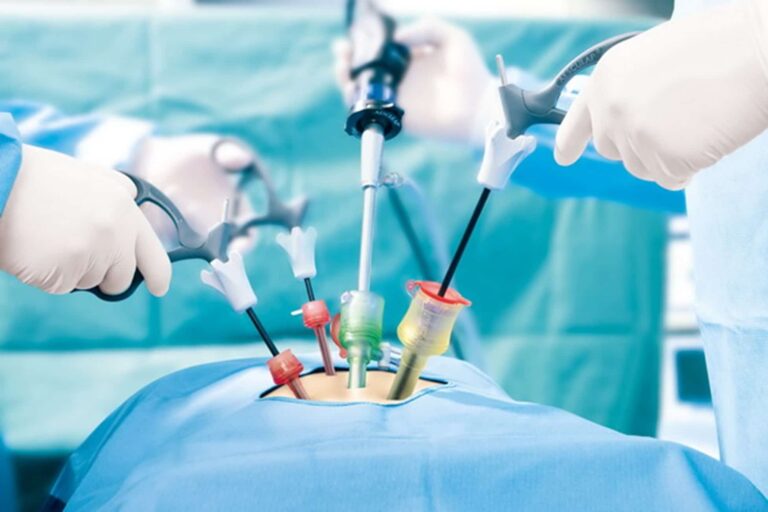Exploring Laparotomy: Procedure Indications and Recovery.
Laparotomy, a surgical procedure involving the opening of the abdominal cavity, is a cornerstone of modern surgical practice. While minimally invasive techniques such as laparoscopy have gained popularity in recent years, laparotomy remains an essential approach for various diagnostic and therapeutic interventions in abdominal surgery. This article aims to explore the procedure, indications, and recovery associated with laparotomy.
To Know More About It Please Click Here
Understanding Laparotomy:
Laparotomy, derived from the Greek words para (meaning abdomen) and tomos (meaning to cut), involves making a large incision in the abdominal wall to access the organs within the abdominal cavity. Unlike laparoscopy, which utilizes small incisions and a camera-equipped instrument (laparoscope) for visualization, laparotomy provides direct access to the abdominal organs, facilitating a more comprehensive examination and surgical intervention when necessary.
Indications for Laparotomy
Laparotomy may be indicated for a wide range of diagnostic and therapeutic purposes, including
- Exploratory Laparotomy: In cases of abdominal trauma or acute abdominal conditions such as bowel obstruction, perforation, or intra-abdominal bleeding, an exploratory laparotomy may be performed to assess the extent of injury and provide immediate surgical intervention.
- Tumor Resection: Laparotomy may be used to remove abdominal tumors, including those affecting the gastrointestinal tract, reproductive organs, or other structures within the abdominal cavity.
- Gynecological Surgery: Procedures such as hysterectomy, ovarian cystectomy, and tubal ligation may require a laparotomy approach, particularly in cases of large or complex pathology.
- Bowel Surgery: Laparotomy is commonly employed for various bowel surgeries, including resection of diseased segments, repair of perforations, and creation of stomas (e.g., colostomy or ileostomy).
- Organ Transplantation: During abdominal organ transplantation procedures (e.g., kidney, liver, pancreas), laparotomy provides access to the donor and recipient organs, facilitating meticulous surgical techniques and optimal organ placement.
Procedure:
The laparotomy procedure typically involves the following steps:
- Preparation: The patient is positioned on the operating table, and general anesthesia is administered to ensure comfort and immobility throughout the procedure. The abdomen is cleansed and draped in a sterile fashion to reduce the risk of infection.
- Incision: The surgeon makes a midline or transverse incision in the abdominal wall, depending on the specific surgical indication and patient factors. The incision may extend from the xiphoid process to the pubic symphysis (midline incision) or be localized to a specific area of interest.
- Exploration: Upon entering the abdominal cavity, the surgeon carefully inspects the organs and structures for any abnormalities, trauma, or pathology. In cases of exploratory laparotomy, the extent of injury or disease is assessed to guide subsequent interventions.
- Intervention: Depending on the surgical indication, various procedures may be performed, including tumor resection, bowel resection, and anastomosis, repair of injured organs, or transplantation of donor organs.
- Closure: Once the surgical objectives have been achieved, the abdominal incision is meticulously closed in layers using sutures or staples. Drains may be placed to remove excess fluid or blood from the surgical site, and the incision is covered with sterile dressings.
Recovery and Postoperative Care:
The recovery process following laparotomy varies depending on the complexity of the procedure, the underlying condition being treated, and individual patient factors. However, certain general principles apply:
- Pain Management: Patients may experience discomfort or pain at the surgical site following laparotomy. Pain medications, both oral and intravenous, are prescribed to alleviate discomfort and facilitate mobility.
- Mobility and Activity: Early mobilization is encouraged to prevent complications such as deep vein thrombosis and respiratory compromise. Patients are typically instructed to gradually increase activity levels while avoiding heavy lifting and strenuous activities during the initial recovery period.
- Dietary Progression: Oral intake is gradually initiated, starting with clear liquids and advancing to a regular diet as tolerated. In some cases, dietary restrictions may be necessary, particularly following bowel surgery or gastrointestinal procedures.
- Wound Care: Proper wound care is essential to promote healing and prevent infection. Patients are instructed to keep the incision site clean and dry, adhere to any specific wound care instructions provided by their healthcare provider, and monitor for signs of infection such as redness, swelling, or drainage.
- Follow-up Care: Regular follow-up appointments with the surgical team are scheduled to monitor recovery progress, assess wound healing, and address any concerns or complications that may arise. Depending on the nature of the surgery, additional imaging studies or laboratory tests may be ordered to evaluate treatment outcomes.
To Know More About It Please Click Here
Conclusion:
Laparotomy remains a valuable surgical approach for a wide range of abdominal conditions, offering both diagnostic capabilities and therapeutic interventions. While minimally invasive techniques continue to evolve, laparotomy remains indispensable for cases requiring direct visualization and comprehensive surgical management. By understanding the indications, procedures, and recovery associated with laparotomy, healthcare providers can ensure optimal outcomes for patients undergoing abdominal surgery.







